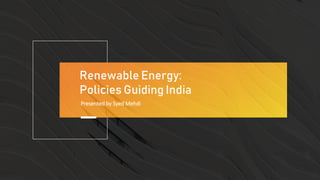Energy Law Presentation.pptx
•Download as PPTX, PDF•
0 likes•31 views
Energy Law
Report
Share
Report
Share

Recommended
Environment & Green TechnologyNortech Trinity Enviornment & Green Technology Opportunities 2018

Nortech Trinity Enviornment & Green Technology Opportunities 2018Nortech Trinity India Private Limited
Recommended
Environment & Green TechnologyNortech Trinity Enviornment & Green Technology Opportunities 2018

Nortech Trinity Enviornment & Green Technology Opportunities 2018Nortech Trinity India Private Limited
More Related Content
Similar to Energy Law Presentation.pptx
Similar to Energy Law Presentation.pptx (20)
Renewable Energy: An Assessment of Public Awareness in Jhansi 

Renewable Energy: An Assessment of Public Awareness in Jhansi
Renewable Energy: An Assessment of Public Awareness in Jhansi 

Renewable Energy: An Assessment of Public Awareness in Jhansi
IRJET-A Review of Renewable Energy Scenario in India

IRJET-A Review of Renewable Energy Scenario in India
Presentation on ONE SUN ONE WORLD ONE GRID (OSOWOG) policy making

Presentation on ONE SUN ONE WORLD ONE GRID (OSOWOG) policy making
Recently uploaded
Recently uploaded (20)
Petitioner Moot Memorial including Charges and Argument Advanced.docx

Petitioner Moot Memorial including Charges and Argument Advanced.docx
Essential Components of an Effective HIPAA Safeguard Program

Essential Components of an Effective HIPAA Safeguard Program
Common Legal Risks in Hiring and Firing Practices.pdf

Common Legal Risks in Hiring and Firing Practices.pdf
posts-harmful-to-secular-structure-of-the-country-539103-1.pdf

posts-harmful-to-secular-structure-of-the-country-539103-1.pdf
Jim Eiberger Rental Agreement Redacted Former Lease.docx

Jim Eiberger Rental Agreement Redacted Former Lease.docx
Energy Law Presentation.pptx
- 1. Renewable Energy: Policies Guiding India Presented by Syed Mehdi
- 2. Background of Renewable Energy Policies in India An Overview 1. India is a major user of fossil fuels such as coal and crude oil. 2. In terms of overall energy consumption, India ranks sixth in the world. 3. A 10-year comprehensive action plan for supplying energy throughout the nation was created by the Ministry of Power. 4. National Electricity Plan [NEP] also established a second plan to ensure that electricity is supplied to people efficiently and at a fair cost. 5. India is responsible for approximately 6.65 percent of total global carbon emissions, placing it in fourth place. 6. The World Energy Council predicts that worldwide power demand will peak in 2030.
- 3. Literature Review Pappas D., Energy and Industrial Growth in India: The Next Emissions Superpower?, Energy Procedia, pg. 105, Volume 3656-3662 (2017) R. Singh, India’s renewable energy targets: How to overcome a $200 billion funding gap, Renewable Energy Focus, Vol. 27:1-10 (2015) B.S.K Naidu, Indian Scenario of Renewable Energy for Sustainable Development, Energy Policy, Vol. 24 (6), pp. 575-581 (1996). What did we refer to? <- Have a look here! Kindly get in touch for the PDFs.
- 4. Issues Addressed in this Presentation 01 02 44 percent of homes lack access to power, and up to 80,000 communities remain unconnected. This demonstrates that India has been operating with a negative energy balance for decades. Is this seemingly impossible task attainable? First Issue The opportunity cost of delaying India’s transition to a renewable energy system is enormous. International investors look to the Indian government for policy clarity and commitment. Is this a problem that can be solved by prudent policy planning? Second Issue 4
- 5. ANALYSIS OF THE INDIAN SCENARIO India’s activities include all of the major renewable energy sources in which we are interested, including biogas, biomass, solar energy, wind energy, small hydroelectric power, and other emerging technologies, as well as other developing technologies. The Commission for Additional Sources of Energy (CASE), which is housed under the Department of Science and Technology, was established by the Indian government in 1981. India has programs for resource assessment, research and development, technology creation, and demonstration. It is the only nation in the world to have a ministry solely devoted to the development of renewable energy sources, the Ministry of Non-Conventional Energy Sources. 5
- 6. The Plans for Future India intends to lower its emissions intensity by 33–35 percent between 2005 and 2030 as part of its Intended Nationally Determined Contribution (“INDC”). To this end, it is concentrating on increasing clean and renewable energy consumption by 40% by 2030. To say something unrelated to the present Covid; Galwan period’s national RE strategy needs bravery and conviction, unless the statement is founded on facts and data. In 2011, the central government issued a Renewable Power Obligation (RPO) requiring obliged organizations “to acquire not less than 5% of their annual energy consumption from renewable sources until 2015-16. This RPO objective was increased to 21% in 2018 with the goal of achieving it by 2022. As a result, the percentage of grid-connected renewable energy sources, particularly wind and solar, has been rapidly growing. Renewable energy sources account for 87GW (23 percent) of the total installed capacity of 370GW. This comprises 37.7GW (10.1%) wind energy and 32.3GW (8.7%) solar energy. In 2015, the total installed capacity was around 275 GW, comprised of 23 GW (8.3 percent) wind energy and 3.8 GW (1.3 percent) solar energy.” Apart from the environmental advantages, the reduced cost of generating makes it a favored source of energy for policymakers. 6
- 7. CONCLUSION 1. When it comes to environmental policy, India should adopt the UNFCC’s original position of Shared Concern with Differentiated Responsibility; for the states and rethink its present; one size fits all; approach. There’s logic in One Country, One Policy, but not in economics. 2. If the government recalibrates its RE Policy as soon as possible, the damage to the power Sector’s financial viability will be repaired, and the country’s current economic mood would be improved. The economy, the ecology, and politics all benefit from this agreement. 7
- 8. THANK YOU
Editor's Notes
- Photo by Simone Hutsch on Unsplash